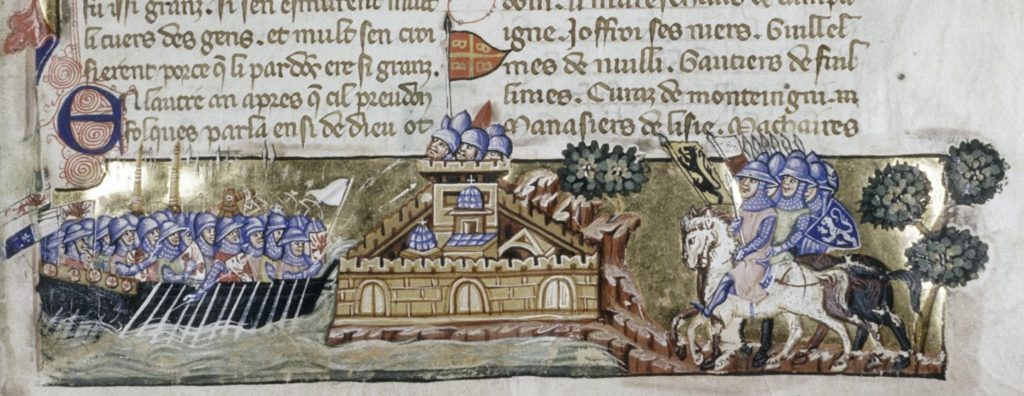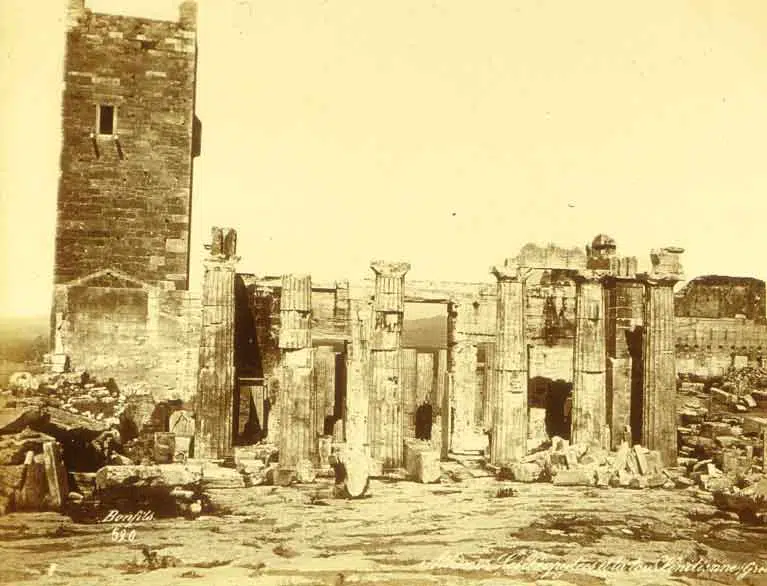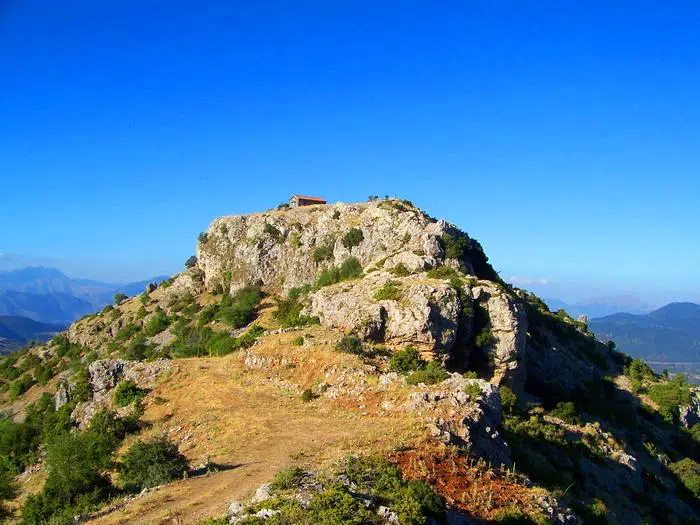
De la Conquête de Constantinople (On the Conquest of Constantinople), one of the oldest surviving examples of French prose, is considered to be the most important historical source on the Fourth Crusade and the tragic Sack of Constantinople.
As disturbing as this part of Byzantine history is and as ugly as it is to see how western Christians treated Eastern Christianity, this relation of the Conquest stands as an invaluable chronicle of the world at the time and what we see now as almost unfathomable misunderstandings that led to the destruction of the Byzantine world as it once was.
The damage that resulted from the sacking of the great city of Constantinople and the political destabilization that occurred ultimately caused its weakening, resulting in its takeover by Turkish forces two centuries later and in their control of the once-glittering Byzantine empire.
Through its pages, we can see just how the Frankish knights’ aims went so awry during the Fourth Crusade to the point that they destroyed much of the second-holiest site in Christianity.
Relation of the Sack of Constantinople one of world’s first histories written by participant
La Conquête de Constantinople was written by Geoffrey of Villehardouin, a knight and crusader, who made this eyewitness account of the successful conquest of the Byzantine Empire’s capital city on April 13, 1204.
The first two paragraphs of the Chronicle are as follows:
Be it known to you that eleven hundred and ninety-seven years after the Incarnation of our Lord Jesus Christ, in the time of Innocent Pope of Rome, and Philip King of France, and Richard King of England, there was in France a holy man named Fulk of Neuilly – which Neuilly is between Lagni-sur-Marne and Paris – and he was a priest and held the cure of the village. And this said Fulk began to speak of God throughout the Isle-de-France, and the other countries round about; and you must know that by him the Lord wrought many miracles.
Be it known to you further, that the fame of this holy man so spread, that it reached the Pope of Rome, Innocent; and the Pope sent to France, and ordered the right worthy man to preach the cross (the Crusade) by his authority. And afterwards the Pope sent a cardinal of his, Master Peter of Capua, who himself had taken the cross, to proclaim the Indulgence of which I now tell you, viz., that all who should take the cross and serve in the host for one year, would be delivered from all the sins they had committed, and acknowledged in confession. And because this indulgence was so great, the hearts of men were much moved, and many took the cross for the greatness of the pardon.

Sack of Constantinople earliest history written in French language
Villehardouin, who lived from 1150 to to 1213, the knight and historian who participated in and chronicled the fearful Fourth Crusade, is considered one of the most important historians of the time since he was there participating in the battle for Constantinople between the Christians of the West and the Christians of the East on April 13, 1204.
His Conquest is the earliest historical prose narrative written in the French language that has survived to modern times.
Three years after the fateful battle in 1207 Geoffroi began to write his chronicle.
The Fourth Crusade, which lasted from 1202 to 1204 was a Latin Christian armed expedition called by Pope Innocent III. The stated intent of the expedition was to recapture the Muslim-controlled city of Jerusalem by first defeating the powerful Egyptian Ayyubid Sultanate, which was the most powerful Muslim state of the time.
However, a catastrophic sequence of funding problems and political misjudgments and blunders culminated in the Crusader army’s 1204 sack of Constantinople, the capital of the Greek-controlled Byzantine Empire, rather than Egypt as had been originally planned.
In the end, this almost unfathomable event led to the partitioning of the once-powerful Byzantine Empire.
Pope summarily excommunicates all knights in Fourth Crusade
Things started to go seriously awry in late 1202 when financial shortfalls led the Crusaders to besiege and sack the Catholic city of Zara (Zadar) on the Adriatic Sea, which was then brought under Venetian control.
The Pope, infuriated that Christian knights had supposedly attacked a Christian city, summarily excommunicated the entire Crusader army from the Catholic Church.
However, this had no apparent effect on the knights. Far from slinking home in ignominy, they continued on their way East. In January of 1203 en route to Jerusalem, the Crusader leadership entered into an agreement with the Byzantine prince, Alexios Angelos, to divert the Crusade to Constantinople and restore his deposed father Isaac II Angelos as emperor.
The intent of the Crusaders was then to continue to Jerusalem after having received the promised Byzantine financial and military aid. On June 23, 1203, some of the Crusaders reached Constantinople while other contingents (which perhaps constituted the majority of all crusaders) continued to Acre in what is northern Israel today.
Two months later, in August, following the siege of Constantinople, Alexios was crowned co-emperor. However, by January 1204, he was deposed by a popular uprising, resulting in a great loss of their expected operating funds from Alexios.
Following Alexios’ murder on February 8th, the Crusaders decided to undertake the outright conquest of the city as a means to get the treasure they had been promised. In April of 1204, they captured the city, plundering and looting its enormous wealth at will. Only a mere handful of the Crusaders continued on to the Holy Land after the sack of Constantinople, however, belying their stated motives.

Sack of Constantinople led to downfall of the entire Byzantine Empire
What followed was nothing less than the complete fragmentation of the Byzantine Empire into three states centered in Nicaea, Trebizond, and Epirus. The Crusaders then founded several new Crusader states, known as the Frankokratia, in former Byzantine territory, as what they called the Latin Empire of Constantinople.
Naturally, the presence of the Western Crusader states almost immediately led to war with the Byzantine successor states and with the Bulgarian Empire. The Nicaean Empire eventually recovered Constantinople and restored the Byzantine Empire in 1261, but it never recovered fully from the political upheaval caused by Alexios and the subsequent sacking of the city.
The Fourth Crusade is considered to have solidified the East–West Schism of Christianity, which had already begun after a succession of ecclesiastical differences and theological disputes between the Greek East and Latin West before the formal ecclesiastical split that occurred in 1054.
Prominent among these were the procession of the Holy Spirit from God (the Filioque); whether leavened or unleavened bread should be used in the Eucharist; the bishop of Rome’s claim to universal jurisdiction; and the place of the See of Constantinople in relation to the pentarchy. The latter concept refers to how the Christian church is governed by the patriarchs of the five major episcopal sees of the Roman Empire—that is, Rome, Constantinople, Alexandria, Antioch, and Jerusalem.
Chronicler’s nephew becomes Prince of Achaia
After the Fourth Crusade and the resultant Sack of Constantinople dealt an irrevocable blow to the Byzantine Empire, in an especially ironic turn of events, Villehardouin’s nephew Geoffroi I of Villehardouin went on to become Prince of Achaea in Morea, the medieval name for the Peloponnesian peninsula, in 1209.
The ruins of what was once his summer home are still atop a mountain in Achaea; the fairly-well preserved Medieval-era ruins of the Franks in the Morea still fascinate tourists and draw them to the area. Meanwhile, Villehardouin himself seems to have passed away shortly afterward.
Villehardouin had been present at the origins of the Crusade during the 1199 tournament held by Thibauld III of Champagne. Throughout the five-year-long Crusade, he acted as an envoy, ambassador, councilman, and even a military leader at the Battle of Adrianople in 1205. Several years later, Villehardouin took the time to record his account.
Villehardouin chose to write his work in epic fashion in the third-person, and he combines objectivity (an extremely unusual concept in those times) and ecclesiastical points of view. A common technique in his work is to narrate a battle or episode along subjective and even militaristic guidelines and follow this with his personal and religious explanation of what the results were.
Villehardouin makes constant hints and references to future events and the inability of the men taking part in events at the time to know what the outcomes will be. However, his objectivity is curtailed, as he defined the outcome in his own terms, without allowing his readers to reach their own conclusions.
He recounts the events leading to Alexis’ fateful negotiations with the Crusaders.
Villehardouin knew Fourth Crusade was of great and enduring political magnitude
The Fourth Crusade, Villehardouin realized, was more than a Holy War alone; it was a political event of such enormous magnitude that he knew he had to capture it in great detail, describing the motivations of the actors as completely as possible.
For example, Villehardouin describes the Doge of Venice, Enrico Dandolo, as a blind man who valiantly leads his men into battle. Most likely, he was just near-sighted or had poor eyesight overall. Knowing the long-lasting import of the Crusades, the Frenchman makes many references to the historical epic “The Song of Roland.” Much like this earlier epic, Villehardouin describes the Frankish knights as having been elected to execute God’s will.
Villehardouin’s words—while sometimes accurate and other times not—present a vivid personal account of the Fourth Crusade. At the outset, Villehardouin states that he is a pilgrim as all crusaders were supposed to be when they were instigated after Christian pilgrims were stopped from visiting the Holy Land, but he never explains this tenet of the Crusade.
Another glaring omission is any explanation of the religious rabble-rouser Fulk of Neuilly’s influence on the origins of the catastrophic Fourth Crusade although he is mentioned at the outset.
Villehardouin captures the Council at Zara in great detail and creates a more or less accurate view of this portion of the Crusade. He describes how Zara’s citizens pleaded with the Crusaders not to attack a Christian city and gives an unbiased description of the looting by the Crusaders.
Many French Knights refused to attack Zara, left army
He also points out that the knights from France refused to attack Zara and that many then immediately deserted the Crusader army. This matter-of-fact manner of the recording of history continues with his description of the Siege at Constantinople, as well.
He is clearly appalled at the actions of the Crusaders and describes the destruction and theft of objects of inestimable value. He stated with awe that the great city of Constantinople had priceless ancient relics that were equivalent to what the rest of the world possessed combined.
Scholars say that throughout his book, Villehardouin shows an understanding of history and of Greek culture that allows for a more complete view than what one may be inclined to believe, knowing that he was a Crusader himself.
New “Latin Empire” centered in Constantinople
The Latin Empire (1204–1261), centered in Constantinople, and encompassing Thrace and Bithynia, was created as the successor of the Byzantine Empire after the Fourth Crusade while also exercising nominal suzerainty over the other Crusader principalities. Its territories were gradually reduced to little more than the capital, which was eventually captured by the Empire of Nicaea in 1261.
The Principality of Achaea, which was an entity existing from 1205 to 1432, encompassed the Morea or Peloponnesian peninsula. It quickly emerged as the strongest state in the new Latinized empire and prospered even after its demise. Its main rival was the Byzantine Despotate of the Morea, which eventually succeeded in conquering the Principality.
The Duchy of Athens, which existed as a political entity from 1205 to 1458, with its two capitals of Thebes and Athens, encompassed Attica, Boeotia, and parts of southern Thessaly.
In 1311, the Duchy was conquered by the Catalan Company, and in 1388, it passed into the hands of the Florentine Acciaiuoli family, which held on to it until the Ottoman conquest in 1456.
The Greek island of Rhodes became the headquarters of the military monastic order of the Knights Hospitaller of Saint John in 1310, and the Knights retained control of the island and the neighboring islands of the Dodecanese island group until ousted by the Ottomans in 1522.
The Republic of Venice also took possession of some Greek lands, which formed part of its “Stato da Màr.” Some of them survived until the fall of the Republic itself in 1797. The whole of the Peloponnese or Morea was conquered during the Morean War in the 1680s and became a colony as the “Kingdom of the Morea,” but it was lost again to the Ottomans in 1715.
While the Greek successor states to the Byzantine Empire reconquered many areas, with the exception of the Ionian Islands and some islands or forts which remained in Venetian hands until the turn of the 19th century, the end of the Frankokratia in most Greek lands came only with the Ottoman conquest and reign, known as the “Tourkokratia,” from the 14th through the 17th centuries.
See all the latest news from Greece and the world at Greekreporter.com. Contact our newsroom to report an update or send your story, photos and videos. Follow GR on Google News and subscribe here to our daily email!



